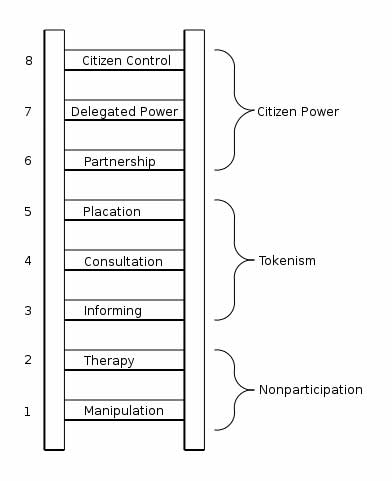I was doing some research at the library recently and I stumbled across this article from 1969 titled, “A Ladder of Citizen Participation,” by Sherry R. Arnstein.
In her article, Arnstein sets up a typology to explain the varying degrees of participation regular Joes (“have-nots”) are afforded by those in power (“haves”). She simplifies these into eight categories, or rungs on a ladder:

Here’s a good summary explanation of each rung:
1 Manipulation and 2 Therapy. Both are non participative. The aim is to cure or educate the participants. The proposed plan is best and the job of participation is to achieve public support by public relations.
3 Informing. A most important first step to legitimate participation. But too frequently the emphasis is on a one way flow of information. No channel for feedback.
4 Consultation. Again a legitimate step attitude surveys, neighbourhood meetings and public enquiries. But Arnstein still feels this is just a window dressing ritual.
5 Placation. For example, co-option of hand-picked ‘worthies’ onto committees. It allows citizens to advise or plan ad infinitum but retains for power holders the right to judge the legitimacy or feasibility of the advice.
6 Partnership. Power is in fact redistributed through negotiation between citizens and power holders. Planning and decision-making responsibilities are shared e.g. through joint committees.
7 Delegated power. Citizens holding a clear majority of seats on committees with delegated powers to make decisions. Public now has the power to assure accountability of the programme to them.
8 Citizen Control. Have-nots handle the entire job of planning, policy making and managing a programme e.g. neighbourhood corporation with no intermediaries between it and the source of funds.
I don’t know about you, but this ladder rings true to me. I certainly have experienced manipulation as described here. I’ve been to many meetings that were billed as an opportunity to participate in a process only to discover that it was really just an opportunity for the real decision-makers to try to overcome public objections and extol the virtues of their plan. Then afterwards they could say that everyone had a chance to be heard, and that the public input was taken into consideration — even though no changes had been made.
I think this could be a good tool for evaluating public input opportunities from various municipal organizations in Peoria. Where do you think recent public input opportunities fall on Arnstein’s Ladder? For instance:
- Public input on the location of the new school in the Woodruff attendance area
- Surveys on the new name for the Peoria Regional Museum
- The Target: Peoria crime forum
Finally, do you think (as the Journal Star apparently does) that we have full “Citizen Power” by virtue of our elected representatives on these various municipal organizations?

My guess, and maybe I’m being a tad generous, is that most stuff around here hovers around placation. With just a few forays into partnership.
Locally we operate between steps 3 and 5, with occasional forays into partnership as CGiselle noted.
I think partnership is ideal. It gives citizens a legitimate stake in the process. You do need some control from elected officials as they know how to navigate the political process and governmental institution.